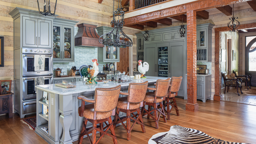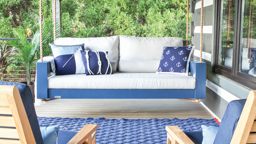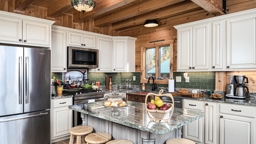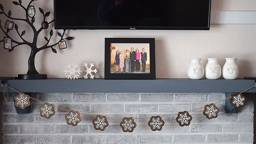
Dreams. This is where every log homeowner’s journey begins. Drooling over magazine photos and model homes, analyzing ideas, searching for that unique floor plan that says, “I’m the one.”
Even if you’re designing your home yourself, chances are you’ve taken more than a passing glance at the stash of log home stock plans out there. And if you are going with one of your log home producer’s plans, you’ll more than likely make a few modifications. Follow our six steps to log home design success, and you’ll get beyond mere dreams and start making real plans.
1. Find a Designer
First, determine whether you should hire an independent architect or work with a designer from your log home company’s team. Before deciding, meet with every one of your potential candidates. Think about the kind of relationship you want with that person and make sure you feel comfortable sharing ideas and talking with him or her openly.
Remember: You’ll be working closely with your designer for quite some time, so you will want to feel at ease. Once you’ve selected this talented pro, you should meet face to face several times throughout the design process. When you get together, don’t be afraid to voice your ideas, even if they seem far-fetched.
A good designer is also a good listener who strives to incorporate as many of your requests into the plan as possible while tempering your wish list with a healthy dose of realism.
2. Get More for Your Money
Be prepared for your architect or designer to ask you outright about your budget (and they will). It’s important to share accurate information about how much you’re willing and able to spend. Ask yourself the tough questions: What can I afford? What can we put off until later? What can I do without?
Though it may be tempting to design your dream log home first and then cut amenities out until you can afford it, this practice can quickly become an exercise in frustration and disappointment. Not to mention, it can wind up costing you more in unnecessary design fees. There are plenty of tricks of the trade for stretching the almighty dollar during the initial design process.
Your home’s size, coupled with wise material choices, for example, can help shape its overall design and its cost. In fact, clever use of expensive materials allows for more wishing and less money dishing.
For example, many buyers want a fieldstone fireplace — a pricey endeavor. Not everyone can afford a four-sided, freestanding hearth; however, many can afford to install fieldstone around the fireplace opening.
By hiding the chimney and moving the hearth to a wall, you’ll eliminate three fieldstone walls and potentially save tens of thousands of dollars.
3. The Forecast Calls for Brainstorming
You wouldn’t pack for vacation without checking your destination’s weather forecast. It’s best to do a little research upfront so you can reduce your chances for surprise down the line. It’s the same with home design. To find the plan that fits your life, you must first define what your future needs might be. If you’re a family of five with children from tots to teens, then room size, traffic flow and privacy issues must be addressed.
If you’re a master chef (or at least you like to think so), consider reducing the distance from the front door or the garage entry to the kitchen, so groceries will be easy to haul. If you’re a Baby Boomer on the brink of retirement, a main-level master suite might keep you in your home for the long term. Give all the residents of your future log home the opportunity to contribute to the design process.
Prepare a wish list of everything each person would like to have in the house; then see where there are similarities. These uniform features likely will make the final cut. Next, think about your budget. Which items are doable? Which can be put on hold? Start whittling until you have a home that fits how you and your family will live and one you can afford.
4. Floor Plan Fantasies
With your essentials covered, it’s time to indulge in all those fun extras like wraparound porches, exercise rooms, home offices/libraries and wet bars. Bring your ideas to the table and ask your designer if they’ll work within your budget.
Many of your requests may be feasible; especially if what you really want is more room. Walls of windows, sky-high kitchen cabinets and a generally open-concept design can make a smaller home feel spacious. Of course, your designer should be realistic about what can and should be included.
Remember: Just because it may not be feasible now doesn’t mean it can’t be done one day.
5. Alterations Are Inevitable
If budget or topography makes it hard to squeeze in everything you want, don’t be too disappointed. In time, you may be able to add many of the items you originally hoped for, if your plan is left open-ended.
Many people attach decks, porches and garages late in the game. Some add half-baths while others glam up the master suite, but the majority of log home plans look to better adapt their plans to their sites.
Designers estimate two review-and-revise cycles to get it right. It may take a few more rounds before you’re comfortable signing off on it, and that’s not only expected, it’s crucial.
6. Take Your Time
Deadlines are omnipresent when planning and building a home, but try not to feel like there’s a clock ticking over your head. Making rushed decisions about your floor plan is never a good idea. Usually the only people who express regret about some aspect of their home usually preface the statement by saying, “If only I had taken the time…” Savor the journey.
The Right to Choose and Use
When you’re ready to purchase a floor plan from a log home company or designer, be aware that you won’t own the actual plan — just a one-time right to build the home. This is necessary to protect both the company and you from copyright infringement.
A reputable designer will never knowingly use a copyrighted plan from another company. If you do plan to build or alter an existing floor plan from a designer other than your own, make sure to get permission.
To protect yourself from copyright violations, remember the following tips:
- Under U.S. copyright law, a floor plan is protected the moment it is created, regardless of whether or not the creator has registered the plan with the U.S. Copyright Office.
- Copyright applies to the interior layout of a home as well as the elevations and exterior design.
- When you buy construction documents, you are actually buying a one-time license to build that house.
- Copyright law also protects derivations of the original plan. You cannot change a wall or roofline and consider it your own plan.
Taking Stock
Tricks that will transform a standard plan into your ideal custom log home.
Coming up with a truly unique home design these days is tough. They all have to have the same basic components, and in terms of flow, some layouts just make more sense than others. For the log home buyer, that’s good news, because chances are your log home producer has designed and manufactured a home that reflects your needs — or comes pretty darn close.
On top of that, just about every manufacturer or handcrafter expects that you will want to make some tweaks to a stock floor plan, and they are ready and willing to accommodate you. Armed with this knowledge, you can save thousands of dollars in design fees and still get the log home you long for.
Here are some easy floor plan modification dos and don’ts to tuck in your bag of tricks as you peruse stock plans:
Do:
- Combine two conjoined bedrooms into one oversized master suite.
- Enclose a rear porch to become a mudroom.
- Incorporate shed-dormers on the second floor to increase headroom/usable square footage at a minimal cost.
- Connect a detached garage with a breezeway for convenience and give the illusion of a larger house by elongating the look of the exterior facade.
- Utilize space above the garage as an entertainment area or media room. (This is sometimes referred to as a FROG – family room over garage.)
- Reduce hallways by eliminating non-load bearing interior walls to create the coveted open-concept design.
- Add or move cross windows for improved ventilation and a clear line of sight from one side of the house to the other.
- Ditch formal dining rooms in favor of larger great room space.
-
Add porches and decks to change up the exterior look and increase outdoor living space.
Don’t:
- Increase the width the plan. If you want to increase the square footage, make it longer instead. As a general rule, increasing the length won’t affect the house structurally. However, going wider likely will mean re-engineering trusses and rafters to properly support the load.
- Overdo it. There comes a time when you may be making too many changes. Remember there is typically a fee for rejiggering stock plans and the more changes you make, the more costly it will become, negating the savings of starting with a stock plan in the first place.
- Settle for less. If you are spending $400,000 on a house, don’t be afraid to spend $4,000 on a set of plans. That doesn’t mean you have to pay for custom drawings. Typically revisions to a stock plan cost an additional 20 to 30 percent on top of the plan itself. Getting exactly the home you want is worth the nominal fee.











